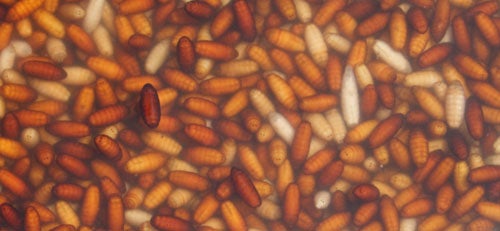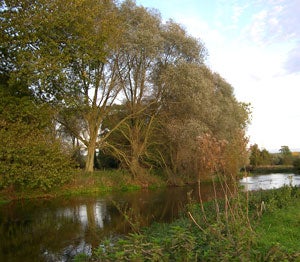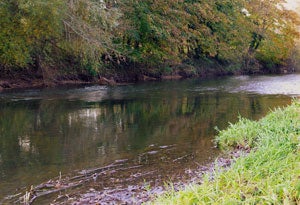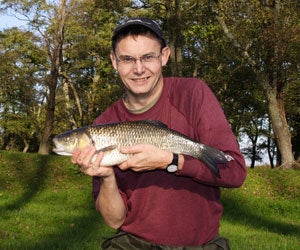| MARK WINTLE | |
Are you stuck in a rut fishing the same swim every week? Do you dare to try something different and see a whole new world of angling open up? Yes? Then read Mark Wintle’s regular column. |
Wintle’s World – CastersBack in the summer, my obsession with using pellets as bait and feed started to wane. I was combining sessions after roach and crucians with some after carp, and when I had leftover casters I was using them to feed the carp. There was little doubt that the carp loved casters.As autumn approached, the Gold Valley Aces vs Chavs match presented an ideal opportunity for some roach fishing on the pole using casters, and so it proved. My confidence in casters as a bait was steadily returning. I found it hard to fathom why I’d gone off using casters after using them so much for thirty years. I suppose it was a mixture of cost, indifferent quality casters, and the sheer convenience of pellets that last for months, unlike casters which remain in top class condition for just a couple of days. But my local tackle shop had changed supplier for its casters and this alone made me more inclined to start using them again. There’s more to the Stour than ThroopThe final part of the rediscovery was in late October and early November when extremely low and clear conditions on my local Dorset Stour warranted a return to my traditional tactics.
When people mention the Dorset Stour, most people automatically think of Throop but there is a huge amount of other water that is much quieter even if it is less productive of massive chub. When you can get an entire mile-plus of water to yourself with no other anglers, no dog walkers, etc, then angling becomes what it ought to be, a pleasure. You can work out for yourself where the fish might be, tackle a variety of barely-fished swims and please yourself. The first weekend I fished the busy Royalty in the morning for a succession of small dace then switched to the Stour for a dozen roach on caster and waggler plus dace. The river was already low but this whetted my appetite. Better prepared and armed with hemp and castersI was better prepared the next weekend, armed with hemp and casters, and with a shallow glide in mind, made the trek to the river, arriving around lunchtime. With a gentle breeze off my back I opted for a 5 no. 4 stick float, bunching most of the shot under the float, with a size 18 hook. I knew from old that chub might be present as well as roach and dace.Casters are traditionally a slow bait so it was a case of gentle but steady feeding for the first hour, being patient to get the swim to respond. After an hour, I had my first bite. I was expecting dace to show first but it was a good chub that I’d hooked, and with no real snags just a case of easing it in, letting it tire, and then slipping the net under it. At three pounds, it was a good start. I experimented with a keepnetThose that know me well know my views on keepnets but as an experiment, and knowing I would stick with one swim I had decided to use one for a change. Despite the shallowness of the swim it was possible to stake it out in a little deep run close in. After that first chub, I had a couple of chublets then a run of roach around four to six ounces before a shoal of dace came along. All the while, I kept the steady, light feed of half a dozen casters and a dozen grains of hempseed going in. A mixture of dace and roach followed, with the odd chublet.
A week later, I was backThis time I used an access further upstream and chose a glide on an overgrown stretch. Conditions were tougher than the previous week. The continuing lack of rain meant that the river was even clearer and had dropped two inches. To make matters worse the wind was a gusty down-streamer that funnelled down the river.Try as I might I struggled to get a stick float to trot down the swim in anything like a straight line. After twenty minutes, I decided to walk back up river to the swim I’d fished two weeks before where there was some shelter from the skimming wind. I switched to a waggler and despite the wind, I found I could fish this reasonably well. Only one problem: where were the fish? After half an hour and just two minnows, I seemed to be getting nowhere. With not much more than two hours left before dark, I made the long walk downstream to the shallows I’d fished the previous week. 0.12mm line and an 18’s hook was too crudeWhen I got there, the wind was not too bad but I could not see myself fishing a stick as the wind was still downstream. The waggler I had already tackled up was a little on the large side but would be easy to control. It took half an hour to get the first fish, a dace of four ounces quickly followed by a chublet and a couple of roach. I sensed that there were more fish present and that the size 18 hook to 0.12mm was simply too crude for the conditions. I switched to a 20 to 0.10mm with just a no. 8 and no. 10 down the line. The first chub at just over four pounds turned up soon afterwards.
Just a week later, the weekend of the first round of the species race, the Sunday brought enough rain for the first proper flush through of the late autumn and as it fined down it was perfect for big roach on bread. But that’s another story. Unknown potential and casters will figureThis stretch offers unknown potential. I know there are plenty of chub, roach and dace, and some big perch. If conditions allow I shall be back, and I’ll be trying to locate the big roach which must be somewhere along its length; I know there are big perch and chub present.Casters will play a bigger part in my fishing methods than previous years depending on the conditions. Only time can tell what this winter will bring, the ideal caster fishing conditions are when the river is normal, reasonably clear and average temperatures. When it is very cold and clear I think it is better to fish with maggots. In milder temperatures, the small stuff is more active and casters will beat the minnows, bleak and tiny dace. I’ll let you know how I get on. |















